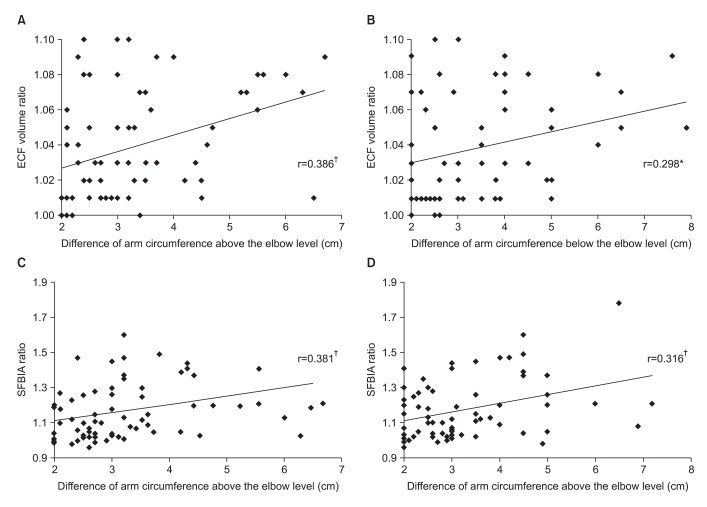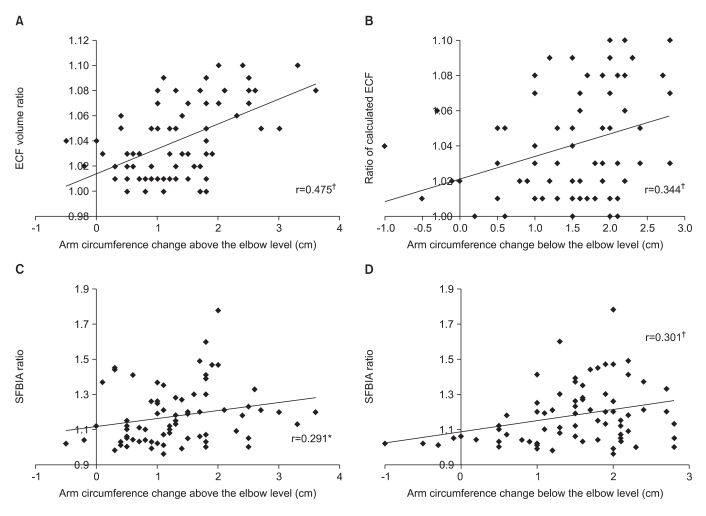Ann Rehabil Med.
2011 Oct;35(5):687-693. 10.5535/arm.2011.35.5.687.
Prediction of Treatment Outcome with Bioimpedance Measurements in Breast Cancer Related Lymphedema Patients
- Affiliations
-
- 1Department of Rehabilitation Medicine, Asan Medical Center, University of Ulsan College of Medicine, Seoul 138-736, Korea. jyjeon@medimail.co.kr
- 2Department of Clinical Epidemiology and Biostatistics, Asan Medical Center, University of Ulsan College of Medicine, Seoul 138-736, Korea.
- KMID: 2267231
- DOI: http://doi.org/10.5535/arm.2011.35.5.687
Abstract
OBJECTIVE
To investigate the usefulness of bioimpedance measurement for predicting the treatment outcome in breast cancer related lymphedema (BCRL) patients. METHOD: Unilateral BCRL patients who received complex decongestive therapy (CDT) for 2 weeks (5 days per week) were enrolled in this study. We measured the ratio of extracellular fluid (ECF) volume by using bioelectrical impedance spectroscopy (BIS), and single frequency bioimpedance analysis (SFBIA) at a 5 kHz frequency before treatment. Arm circumferences were measured at 10 cm above and below the elbow before and after treatment. We also investigated whether there is correlation between ECF ratio and SFBIA ratio with the change of arm circumference after CDT.
RESULTS
A total of 73 patients were enrolled in this study. The higher ECF ratio was significantly correlated with higher reduction of arm circumference at both above and below the elbow after treatment, but the higher SFBIA ratio was correlated only with the higher reduction of arm circumference below the elbow.
CONCLUSION
These results show that ECF volume measurements and SFBIA before treatment are useful tools for predicting the outcome of patients with lymphedema. We concluded that ECF volume measure can be used as a screening tool for predicting treatment outcome of BCRL patients.
Keyword
MeSH Terms
Figure
Cited by 2 articles
-
Effects of Different Bandaging Methods for Treating Patients With Breast Cancer-Related Lymphedema
Se Hyun Oh, Sung Hwan Ryu, Ho Joong Jeong, Jung Hyun Lee, Young-Joo Sim
Ann Rehabil Med. 2019;43(6):677-685. doi: 10.5535/arm.2019.43.6.677.Bioimpedance Analysis for Predicting Outcomes of Complex Decongestive Therapy for Gynecological Cancer Related Lymphedema: A Feasibility Study
Su Hwan Bae, Won Jun Kim, Yu Jin Seo, JaYoung Kim, Jae Yong Jeon
Ann Rehabil Med. 2020;44(3):238-245. doi: 10.5535/arm.19102.
Reference
-
1. Warren AG, Brorson H, Borud LJ, Slavin SA. Lymphedema: a comprehensive review. Ann Plast Surg. 2007; 59:464–472. PMID: 17901744.2. Warren AG, Janz BA, Slavin SA, Borud LJ. The use of bioimpedance analysis to evaluate lymphedema. Ann Plast Surg. 2007; 58:541–543. PMID: 17452840.
Article3. Hayes SC, Janda M, Cornish B, Battistutta D, Newman B. Lymphedema after breast cancer: incidence, risk factors, and effect on upper body function. J Clin Oncol. 2008; 26:3536–3542. PMID: 18640935.
Article4. Sener SF, Winchester DJ, Martz CH, Feldman JL, Cavanaugh JA, Winchester DP, Weigel B, Bonnefoi K, Kirby K, Morehead C. Lymphedema after sentinel lymphadenectomy for breast carcinoma. Cancer. 2001; 92:748–752. PMID: 11550143.
Article5. Meneses KD, McNees MP. Upper extremity lymphedema after treatment for breast cancer: a review of the literature. Ostomy Wound Manage. 2007; 53:16–29. PMID: 17551172.6. Erickson VS, Pearson ML, Ganz PA, Adams J, Kahn KL. Arm edema in breast cancer patients. J Natl Cancer Inst. 2001; 93:96–111. PMID: 11208879.
Article7. Carati CJ, Anderson SN, Gannon BJ, Piller NB. Treatment of postmastectomy lymphedema with low-level laser therapy: a double blind, placebo-controlled trial. Cancer. 2003; 98:1114–1122. PMID: 12973834.8. Petrek JA, Heelan MC. Incidence of breast carcinoma-related lymphedema. Cancer. 1998; 83:2776–2781. PMID: 9874397.
Article9. Rietman JS, Dijkstra PU, Geertzen JH, Baas P, de Vries J, Dolsma WV, Groothoff JW, Eisma WH, Hoekstra HJ. Treatment-related upper limb morbidity 1 year after sentinel lymph node biopsy or axillary lymph node dissection for stage I or II breast cancer. Ann Surg Oncol. 2004; 11:1018–1024. PMID: 15525832.
Article10. Szuba A, Rockson SG. Lymphedema: classification, diagnosis and therapy. Vasc Med. 1998; 3:145–156. PMID: 9796078.
Article11. Cornish B. Bioimpedance analysis: scientific background. Lymphat Res Biol. 2006; 4:47–50. PMID: 16569208.
Article12. Ward LC, Czerniec S, Kilbreath SL. Quantitative bioim pedance spectroscopy for the assessment of lymphoedema. Breast Cancer Res Treat. 2009; 117:541–547. PMID: 19082708.13. Cornish BH, Chapman M, Hirst C, Mirolo B, Bunce IH, Ward LC, Thomas BJ. Early diagnosis of lymphedema using multiple frequency bioimpedance. Lymphology. 2001; 34:2–11. PMID: 11307661.14. Ward LC. Bioelectrical impedance analysis: proven utility in lymphedema risk assessment and thera peutic monitoring. Lymphat Res Biol. 2006; 4:51–56. PMID: 16569209.
- Full Text Links
- Actions
-
Cited
- CITED
-
- Close
- Share
- Similar articles
-
- Rapid Lymphedema Progression in Breast Cancer Patient with Previous Forearm Fracture
- Quality of Life, Upper Extremity Function and the Effect of Lymphedema Treatment in Breast Cancer Related Lymphedema Patients
- Comparisons of Physiological and Psychosocial Symptoms for Breast Cancer Patients with and without Lymphedema
- Health-Related Quality of Life in Breast Cancer Patients with Lymphedema Who Survived More than One Year after Surgery
- Bioimpedance Analysis for Predicting Outcomes of Complex Decongestive Therapy for Gynecological Cancer Related Lymphedema: A Feasibility Study



